IN01114 Oval intaglio in sardonyx
Author: ERC team
Oval intaglio in sardonyx engraved with a standing lion; above a brāhmī inscription in two characters, after which a crescent (note: image reversed).
Uploaded on November 6, 2017
May 19, 2020
OB01113 Oval intaglio in rose-coloured garnet
Author: Anon.
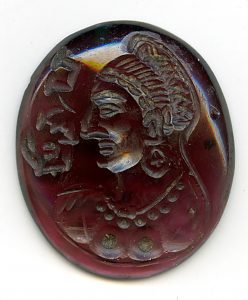
Oval intaglio in rose-coloured garnet engraved with the bust of a woman in profile; before her a brāhmī inscription in three characters. British Museum 1892,1103.121.
Uploaded on November 6, 2017
May 19, 2020
IN01113 Oval intaglio in rose-coloured garnet
Author: ERC team
Oval intaglio in rose-coloured garnet engraved with the bust of a woman in profile; before her a brāhmī inscription in three characters (note: image reversed).
Uploaded on November 6, 2017
May 19, 2020
OB01110 Oval intaglio in an orange-stained stone
Author: Anon.
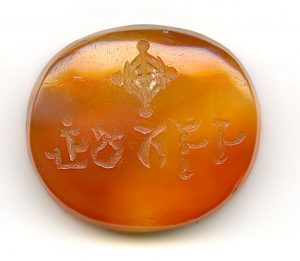
Oval intaglio in an orange-stained stone (cornelian?) inscribed with a pseudo-brāhmī inscription and cakra above. British Museum 1892,1103.117.
Uploaded on November 6, 2017
May 19, 2020
IN01110 Oval intaglio in an orange-stained stone
Author: ERC team
Oval intaglio in an orange-stained stone (cornelian?) inscribed with a pseudo-brāhmī inscription and cakra above (note: image reversed).
Uploaded on November 6, 2017
May 19, 2020
OB01108 Circular lapis lazuli intaglio
Author: Anon.
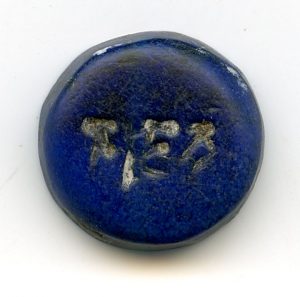
Circular lapis lazuli intaglio engraved with a brāhmī inscription in three characters. British Museum 1892,1103.115.
Uploaded on November 6, 2017
May 19, 2020
IN01108 Circular lapis lazuli intaglio
Author: ERC team
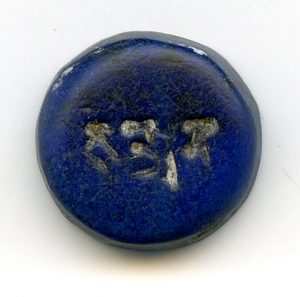
Circular lapis lazuli intaglio engraved with a brāhmī inscription in three characters (note: image reversed).
Uploaded on November 6, 2017
May 19, 2020
IN01118 Rectangular sardonyx intaglio
Author: ERC team
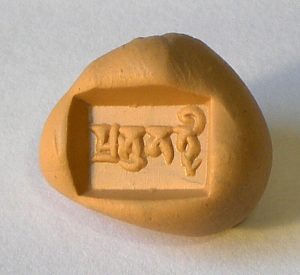
Rectangular sardonyx intaglio with bevelled edges, engraved with a one-line brāhmī inscription (contemporary impression).
Uploaded on November 6, 2017
May 15, 2020
IN03222 Rajagala Inscription of circa 200 B.C. commemorating Saint Mahinda
Author: Senarath Paranavitana
This inscription is engraved on a rock, which stands among the remains of an extensive ancient monastery on the rocky hill called Rājagala or Rāssahela in the Vävugam Patty of the Batticaloa District. It was discovered in 1935 by W. E. Fernando, the Draughtsman of the Archaeological Department, who had been sent by Senarath Paranavitana to explore the site (see Archaeological Survey of Ceylon Annual Report for 1935, p. 9). Fernando prepared an estampage of the inscription but it did not give a clear reading of the latter part of the inscription, which was faint and covered with moss. A clearer estampage was created sometime later, after the site had been opened up for cultivation and cleared of jungle. The inscription is written in early Brāhmī characters and refers to the two theras called Iḍika (P. Iṭṭhiya) and Mahida (P. Mahinda) in connection with a nearby stupa. Since these two theras are described as having come to the island of Sri Lanka from overseas, the Mahida in question can be identified as Saint Mahinda, who travelled from India to preach Buddhism in Sri Lanka in the third century B.C. It is stated in the chronicle that, after Mahinda’s cremation, half of his bodily relics were distributed across the island, to be enshrined in stupas specially built for the purpose. It would seem that one such stupa was erected at Rājagala and the present inscription was engraved to commemorate this fact. In terms of dating, it is not impossible that the stupa was built shortly after Mahinda’s death, which occurred about 200 B.C., with the inscription being incised around the same time. The palaeography contains nothing that militates against this view.
Uploaded on November 6, 2017
May 14, 2020
IN03200 Tim̆biriväva Rock Inscription of the Reign of Goṭhābhaya
Author: Senarath Paranavitana
This inscription is engraved on a rock near the ruined stupa on the ancient site now known as Veheragala at Tim̆biriväva in the Mahapotāna Kōraḷē West of the Anurādhapura District. There are four other inscriptions on the same rock, all of which are more or less fragmentary. Written in the Brāhmī script of the early centuries A.D., these records were first brought to notice by H. C. P. Bell in 1896. The present inscription registers the gift of a tank by a lady named Anuḷabi to the monastery called Gagapavata, which was doubtless the name of the ancient vihara at the site. It is dated in the second year of King Mekavaṇa Aba, who is described as the son of the great king Sirinaka (Sirināga). Bell took Mekavaṇa Aba to the same as Sirimeghavaṇṇa, the son of Mahāsena. However, highlighting a number of flaws in Bell’s reasoning, Senarath Paranavitana argued instead that Mekavaṇa Aba should be identified with Goṭhābhaya, the father of Mahāsena. The identity of Goṭhābhaya’s father is not recorded in the chronicles but Paranavitana suggested that he may have been Sirināga II, identifying both kings as members of the dynasty founded by Vasabha. (Paranavitana’s genealogical table of this dynasty can be viewed here.)
Uploaded on November 6, 2017
April 22, 2020
IN03196 Pālamōṭṭai Slab Inscription
Author: Senarath Paranavitana
This inscription is engraved on a stone slab, which was discovered by Senarath Paranavitana in 1933. Paranavitana found the slab among the ruins of a Śaiva kōvil at a place named Pālamōṭṭai near Kantaḷāy in the Trincomalee District of the Eastern Province. The architectural style of these ruins suggests that they date from the Poḷonnaruva period – a conclusion which is confirmed by the inscription. The inscription is badly weathered and some letters in the first four lines can only be read conjecturally. Due to the damaged condition of the record, it is difficult to decipher the name of the king in whose reign the record is dated. Senarath Paranavitana initially read the king’s name as Jayabāhu and the regnal year as the eighth (Archaeological Survey of Ceylon Annual Report for 1933, p. 14). However, after consulting with K. V. Subrahmanya Aiyer, Paranavitana revised his reading, taking the king’s name to be Vijayabāhu and the number of the regnal year, which is given in figures, to be forty-two (Epigraphia Zeylanica 4, pp. 192–193). If these readings are correct, the inscription can be assigned to the reign of Vijayabāhu I (r. 1056–1111), although this cannot be accepted with certainty.
The purpose of the inscription is to register donations to the god Śiva in the temple named Teṉ-Kailāsam (the Southern Kailāsam) at Kantaḷāy by a female Brahmin named Nāgaiccāṉi in memory of her husband. The inscription also records that the shrine had the name of Vijayarāja Īśvaram and that Kantḷāy was also called Vijayarāja Caturvedimaṅgalam. The appellation of the shrine suggests that it was founded by or under the patronage of Vijayabāhu I. The chronicles and other inscriptions represent this monarch as a great patron of Buddhism but clearly his zeal for Buddhism did not prevent him from extending his patronage to other faiths practiced by his subjects. The term ‘Caturvedimaṅgalam’ frequently features in South Indian inscriptions, where it is appended to the names of villages inhabited by Brahmins. As it was called Vijayarāja Caturvedimaṅgalam, Kantaḷāy must have had a colony of Brahmins who lived there under the protection of Vijayabāhu I. An inscription of king Niśśaṁka Malla found at the site (IN03105) indicates that Kantaḷāy kept its character as a seat of Brahmins for at least a century longer. In the present inscription, the charitable endowment is placed under the protection of the Veḷaikkāra regiment of Śrī Vikkirama Calāmega. As indicated by the Poḷonnaruva Slab Inscription of the Vēḷäikkāṟas (IN03103), the practice of placing a religious institution and its endowments under the protection of a regiment like the Veḷaikkāras was not unknown.
Uploaded on November 6, 2017
April 14, 2020
IN03168 Nāgirikanda Rock Inscription of Kumāradāsa
Author: Senarath Paranavitana
The inscription is engraved on a rock at Nāgirikanda, situated in the Kadavat Kōraḷē of the North-Century Province. This site was the location of an ancient Buddhist monastery, although most vestiges of this ancient foundation were destroyed or obscured by when a new shrine was constructed on the same spot during the Kandyan period. Two inscriptions, both of them engraved on rocks, have been discovered at this place. The earlier one is a short record of three lines, which can be assigned on palaeographic grounds to about the fourth century A.D. The other inscription, which is later and longer, is dealt with here. It was first published in a scholarly context by Edward Müller in his Ancient Inscriptions in Ceylon (1883: 51, 77 and 111, no. 97b) and later featured in the list of inscriptions in the Annual Report of the Archaeological Survey of Ceylon for 1890 (p. 9). The inscription was recopied in 1894 under the direction of H. C. P. Bell and again in 1928 by Senarath Paranavitana, who went on to produce an improved edition and translation of the text for the fourth volume of Epigraphia Zeylanica (pp. 115–128, no. 14). The script of this inscription is of considerable importance, since it represents the transitional stage between Brāhmī and the medieval Sinhalese. The record dates from the sixth century and registers the gift of some tanks and paddy fields to the ancient monastery on the site of the inscription, which was called Bamaṇagiriya, by a king whose name appears to be Maha-Kumaratasa, although that part of the text is quite worn. Paranavitana identified this monarch with the king called Kumāra-Dhātusena in the Mahāvaṁsa and Kumāradāsa in the Pujāvalī and subsequent Sinhalese chronicles. There is some uncertainty around the exact date of this king’s accession to the throne with Geiger, Wijesinghe and Wickremasinghe placing this event in 513, 515 and 570 A.D. respectively.
Uploaded on November 6, 2017
April 5, 2020
IN03064 Jētavanārāma Inscription of Maḷu-Tisa
Author: Don Martino de Zilva Wickremasinghe
H. C. P. Bell discovered the present inscription in 1910 in what was then believed to be the Jētavanārāma dāgaba. This dāgaba has since been shown to be part of the Abhayagiri vihara. The record consists of 16 lines of the top side of a slab, which has been reused to form one of the flag-stones of the pavement at the south altar of the dāgaba. Written in the Southern Brāhmī alphabet of the latter part of the 2nd or the first half of the 3rd century A.D., it records donations from the king Maḷu-Tisa to the Utara-maha-ceta, identified with the Abhayuttara-mahā-cētiya of the Abhayagiri-vihāra, as well as water regulations.
Uploaded on November 6, 2017
November 27, 2019
IN03060 Pālu Mäkiccǟva Rock Inscription of Gaja Bāhu I
Author: Don Martino de Zilva Wickremasinghe
The inscription is situated on a rock at the vāṇa or “spill-water” of an abandoned tank known as Pālu Mäkiccǟva. The tank is situated in the jungle, about 120 yards off the high road to Trincomalee, 16 miles from Anurādhapura. The inscription is composed of six lines, written in Southern Brāhmī alphabet of the latter part of the 2nd century A.D. It records the donation of 5000 kārṣāpaṇas from king Gamiṇi Abaya to the Buddhist priesthood of Tubaraba (Thūpārāma). Gamiṇi Abaya (or Gajabāhuka Gāmaṇī Abhaya) is described as having created the Vaḍamanaka tank in the Upala district but not the Pālu Mäkiccǟva tank, which he appears only to have repaired or deepened. The inscription identifies the Pālu Mäkiccǟva tank as the Abhivaḍḍhamānaka-vāpi tank and says that it was constructed by Gamiṇi Abaya’s grandfather.
Uploaded on November 6, 2017
November 25, 2019